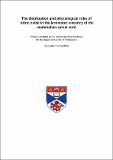The distribution and physiological roles of nitric oxide in the locomotor circuitry of the mammalian spinal cord
Abstract
The mammalian spinal cord contains the neuronal circuitry necessary to generate
rhythmic locomotor activity in the absence of inputs from the higher brain centre or
sensory system. This circuitry is regulated by local neuromodulatory inputs, which can
adjust the strength and timing of locomotor output. The free radical gas nitric oxide has
been shown to act as an important neuromodulator of spinal circuits, which control
locomotion in other vertebrate models such as the tadpole and lamprey. Despite this, the
involvement of the NO-mediated soluble guanylate cyclase/cyclic guanosine
monophosphate secondary messenger-signalling pathway (NO/sGC/cGMP) in
mammalian locomotion has largely been under-investigated.
The NADPH diaphorase histochemical reaction was used to identify sources of NO in
the lumbar spinal cord. The largest population NADPH diaphorase reactive neurons
were located in the dorsal horn, followed by the laminae of the ventral horn, particularly
around the central canal (lamina X) and lamina VII. NADPH diaphorase reactive
neurons were found along a rostrocaudal gradient between lumbar segments L1 to L5.
These results show that that discrete neuronal sources of NO are present in the
developing mouse spinal cord, and that these cells increase in number during the
developmental period postnatal day P1 – P12. NADPH diaphorase was subsequently
used to identify NADPH diaphorase reactive neurons at P12 in the mouse model of
ALS using the SODG93A transgenic mouse.
Physiological recordings of ventral root output were made to assess the contribution of
NO to the regulation induced rhythmic fictive locomotion in the in vitro isolated spinal
cord preparation. Exogenous NO inhibits central pattern generator (CPG) output while
facilitating and inhibiting motor neuron output at low and high concentrations
respectively. Removal of endogenous NO increases CPG output while decreasing motor
neuron output and these effects are mediated by cGMP. These data suggest that an
endogenous tone of NO is involved in the regulation of fictive locomotion and that this
involves the NO/sGC/cGMP pathway.
Intracellular recordings from presumed motor neurons and a heterogeneous,
unidentified sample of interneurons shows that NO modulates the intrinsic properties of
spinal neurons. These data suggest that the net effect of NO appears to be a reduction in
motor neuron excitability.
Type
Thesis, PhD Doctor of Philosophy
Rights
Creative Commons Attribution-NoDerivs 3.0 Unported
http://creativecommons.org/licenses/by-nd/3.0/
Collections
Except where otherwise noted within the work, this item's licence for re-use is described as Creative Commons Attribution-NoDerivs 3.0 Unported
Items in the St Andrews Research Repository are protected by copyright, with all rights reserved, unless otherwise indicated.


